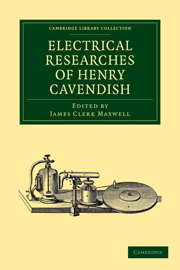Book contents
- Frontmatter
- Contents
- INTRODUCTION BY THE EDITOR
- FIRST PUBLISHED PAPER ON ELECTRICITY
- AN ATTEMPT TO EXPLAIN SOME OF THE PRINCIPAL PHÆNOMENA OF ELECTRICITY, BY MEANS OF AN ELASTIC FLUID
- PART II CONTAINING A COMPARISON OF THE FOREGOING THEORY WITH EXPERIMENT
- PART: [EXPERIMENTS ON COATED PLATES.]
- NOTES
- ALPHABETICAL INDEX
- Plate section
AN ATTEMPT TO EXPLAIN SOME OF THE PRINCIPAL PHÆNOMENA OF ELECTRICITY, BY MEANS OF AN ELASTIC FLUID
Published online by Cambridge University Press: 05 July 2011
- Frontmatter
- Contents
- INTRODUCTION BY THE EDITOR
- FIRST PUBLISHED PAPER ON ELECTRICITY
- AN ATTEMPT TO EXPLAIN SOME OF THE PRINCIPAL PHÆNOMENA OF ELECTRICITY, BY MEANS OF AN ELASTIC FLUID
- PART II CONTAINING A COMPARISON OF THE FOREGOING THEORY WITH EXPERIMENT
- PART: [EXPERIMENTS ON COATED PLATES.]
- NOTES
- ALPHABETICAL INDEX
- Plate section
Summary
1] Since I first wrote the following paper, I find that this way of accounting for the phænomena of electricity is not new. Æpinus, in his Tentamen Theoriœ Electricitatis et Magnetismi, has made use of the same, or nearly the same hypothesis that I have; and the conclusions he draws from it agree nearly with mine, as far as he goes. However, as I have carried the theory much farther than he has done, and have considered the subject in a different, and, I flatter myself, in a more accurate manner, I hope the Society will not think this paper unworthy of their acceptance.
2] The method I propose to follow is, first, to lay down the hypothesis; next, to examine by strict mathematical reasoning, or at least, as strict reasoning as the nature of the subject will admit of, what consequences will flow from thence; and lastly, to examine how far these consequences agree with such experiments as have yet been made on this subject. In a future paper, I intend to give the result of some experiments I am making, with intent to examine still further the truth of this hypothesis, and to find out the law of the electric attraction and repulsion.
HYPOTHESIS.
3] There is a substance, which I call the electric fluid, the particles of which repel each other and attract the particles of all other matter with a force inversely as some less power of the distance than the cube:
- Type
- Chapter
- Information
- Electrical Researches of Henry Cavendish , pp. 1 - 43Publisher: Cambridge University PressPrint publication year: 2010First published in: 1879



